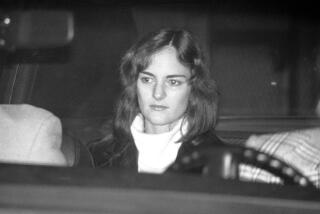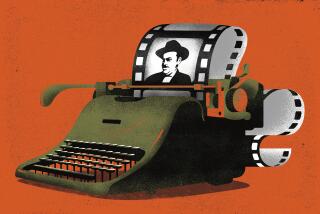Raising ‘Kane’ With Hearst : AN ‘AMERICAN EXPERIENCE’ RECOUNTS THE ATTEMPTS OF THE PUBLISHING MAGNATE TO QUASH A FILM MASTERPIECE
- Share via
Anything that Welles had done that involved controversy benefited him. So it could well be that whatever his motivation for taking on Hearst, he thought that the controversy that would stem from this could only be beneficial. It turned out to be otherwise--terribly so, horribly so.
-- Richard France, PBS’ “American Experience: The Battle Over Citizen Kane”
****
There’s a telling moment in the new PBS “American Experience” documentary “The Battle Over Citizen Kane,” when actor Douglas Fairbanks Jr. remembers the time his father asked William Randolph Hearst why he didn’t give up the newspaper business and concentrate on making motion pictures. Hearst’s reply: “I thought of it, but I decided against it. Because you can crush a man with journalism, and you can’t with motion pictures.”
The fascinating two-hour “Battle Over Citizen Kane” explores how the then-76-year-old Hearst crushed Orson Welles, Hollywood’s “boy wonder” who starred, directed and co-wrote “Citizen Kane.” The landmark 1941 film, considered by many critics and directors to be the greatest movie ever made, painted a brutal portrait of Hearst and his mistress, actress Marion Davies.
“Nobody of our age, in our age, can think of Hearst without thinking of ‘Kane,’ ” says Richard Ben Cramer, co-writer and narrator. “So the two of them are linked, in fact, in our consciousness of the 20th century. They are linked. ... you almost can’t write one without the other.”
Hearst and Welles were very much cut from the same cloth. Both had been raised to believe they could do everything. Hearst made his name by filling his papers with entertaining, often scandalous and sometimes fictional, stories to sell papers. He eventually controlled the first nationwide chain of newspapers. Hearst also collected homes, art and women and spent most of his life in his huge California castle, San Simeon, which was built on property half the size of Rhode Island. Though Hearst was married, his constant companion was actress Marion Davies, a bright, lively, fun-loving woman whom Hearst made a movie star. Part of Hearst’s rage over “Citizen Kane” was the depiction of Davies’ alter ego as a boozy, no-talent opera singer.
Welles was all of 24 when he came to Hollywood in 1939 and decided to take on Hearst. No stranger to controversy and trouble, Welles made headlines with his inventive, bold New York stage productions of “Macbeth” and “Julius Caesar.” At 23, he terrified the nation with his Halloween radio broadcast of “War of the Worlds.” It was Welles’ friend, writer Herman Mankiewicz, who had been a guest at San Simeon, who proposed the story of Hearst to Welles.
But as the documentary points out, there’s just as much of Welles embodied in the film’s Charles Foster Kane as there is Hearst.
Producer and co-writer Thomas Lennon acknowledges that the filmmakers didn’t understand the parallels between Hearst and Welles when they started the project two years ago. “Documentary film, at least the fun ones, offer a process of feeling their way in the dark,” he says. Though Welles’ former co-workers and friends were eager to participate, Lennon adds it was more difficult to get cooperation from the Hearst camp.
“There are people who made a study of Hearst who had no problems talking about it,” Cramer says. “But the people who directly or indirectly are in the Hearst orbit still, I think you could say, were careful about talking.”
“There were other projects,” Lennon says, “that have been started about Hearst that were not able to get completed because of this ongoing resistance.”
Lennon thinks such resistance has been a mistake, “because I think actually one of the things that has happened by virtue of both the silence of the Hearst corporation and also the sheer power of ‘Kane,’ is the image of Hearst has become synonymous with Kane to the point that a couple of years ago, when William Randolph Hearst’s son died, there were headlines that ‘Son of Citizen Kane Dies.’ In other words, that identity has hovered on and on and it is really actually false. [Hearst] was a very different man [from Kane].”
Welles, says Lennon, was excited about the prospect of getting into a fight with Hearst. “He used controversy to take highbrow subject matter or highbrow artistic ambition and make them accessible to large masses of people. That actually is very Hearstian in that he used controversy to get people to read his paper. Welles used controversy to get people to come into his tent--literally, his tent.”
Welles was thrilled when “Kane” came under fire. “He thought it was going very well,” Cramer says. “It was right on his script. The papers were talking about it. The reporters were interviewing him. He was firing off telegrams to RKO. He was threatening to sue. He was a cause celebre. It was perfect Welles controversy.”
But he proved to be no match for Hearst. The publisher pulled out all the stops. He attempted to shut down the production. Hollywood executives, led by MGM’s Louis B. Mayer, tried to purchase the film in order to burn the negative. Pressure was put on exhibitors to refuse to show the movie.
Hearst then started a smear campaign in his papers attacking Welles’ personal life and his liberal political leanings. Simultaneously, the FBI opened a file on Welles.
“Nobody has made the link between the FBI investigation and the ‘Citizen Kane’ controversy before,” Lennon says. “It was most active in the ‘40s and early ‘50s. By the late ‘50s, Welles was living abroad. He had been taken care of pretty good.”
“The American Experience: The Battle Over Citizen Kane” airs Monday at 9 p.m. on PBS.
More to Read
Only good movies
Get the Indie Focus newsletter, Mark Olsen's weekly guide to the world of cinema.
You may occasionally receive promotional content from the Los Angeles Times.











